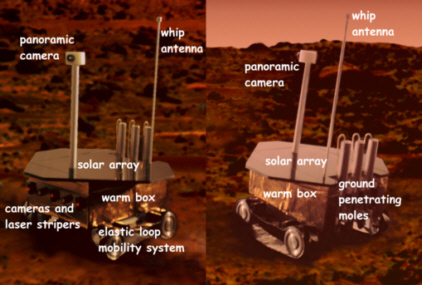| ROBOTIC SPACE MISSIONS |
| EDUCATIONAL PROGRAMS |
| RESOURCES |
| FORTHCOMING EVENTS |
| ORGANISING EVENTS |
| FUNDING BODIES |
| USEFUL CONTACTS |
| PAST MISSIONS |
| CURRENT MISSIONS |
| FUTURE MISSIONS |
| ESA EXOMARS MISSION |
| UK VANGUARD MISSION |
ROBOT SPACE EXPLORERS
UK VANGUARD MISSION
 Vanguard is a new type of robotic
mission for the exploration of Mars. It is designed for subsurface
penetration and investigation using remote instruments. Unlike
previous robotic missions, it offers the opportunity for analysing several
subsurface sites using three ground penetrating moles. The moles
increase the probability that a subsurface signature of life can be found.
There is no provision for returning samples to the surface for analysis;
this minimises the complexity invoked by sophisticated robotic overheads.
The primary scientific instruments to be deployed are a Raman spectrometer,
an infrared spectrometer and a laser-induced breakdown spectroscope.
Vanguard is a new type of robotic
mission for the exploration of Mars. It is designed for subsurface
penetration and investigation using remote instruments. Unlike
previous robotic missions, it offers the opportunity for analysing several
subsurface sites using three ground penetrating moles. The moles
increase the probability that a subsurface signature of life can be found.
There is no provision for returning samples to the surface for analysis;
this minimises the complexity invoked by sophisticated robotic overheads.
The primary scientific instruments to be deployed are a Raman spectrometer,
an infrared spectrometer and a laser-induced breakdown spectroscope.
Designing a Mars Rover
Designing the Vanguard Mars rover,
Endurance, represents a challenging engineering problem. The most important
constraint is mass as this determines the cost, so the mass must be kept
as low as possible. The rover must be designed to survive a wide range
of environments. The structure must cope with the stresses of launch
into space, atmospheric deceleration at Mars, and landing impacts on the
surface. The onboard devices must cope with the low temperature of
space, the high temperature of atmospheric entry, and the low surface temperatures
on Mars. The electronics must cope with high radiation exposure.
Mars also suffers from periodic dust devils and dust storms which can be
highly destructive. These requirements impose a challenging set of
engineering constraints on Endurance's design.
Publications
"Vanguard: a new development in experimental
astrobiology" (Adobe Acrobat .pdf file, 236 KB)
A. Ellery and D. Wynn-Williams
Astronomy & Geophysics 43
(2), pp. 2.22-2.24, 2002.
"Vanguard - a proposed European astrobiology
experiment on Mars" (Adobe Acrobat .pdf file, 159 KB)
A.A. Ellery, C.S. Cockell, H.G.M.
Edwards, D.L. Dickensheets and C.S. Welch
International Journal of Astrobiology 1 (3), pp. 191-199, 2002.
"Preliminary analysis of mobility and suspension systems for a Mars micro rover" (Adobe Acrobat .pdf file, 266 KB)
N. Patel, A. Ellery, C. Welch and A. Curley
2nd World Space Congress, Houston, Paper IAC-02-U.2.08, 2002.
"Elastic loop mobility system: the concept and future prospects for rover mobility on Mars" (Adobe Acrobat .pdf file, 344 KB)
N. Patel, A. Ellery, C. Welch, A. Curley and M. van Winnendael
7th ESA Workshop on Advanced Space Technologies for Robotics and Automation, ESTEC, 2002.
"Why Raman Spectroscopy on Mars? - a case of the right tool for the right job" (Abstract)
A. Ellery and D. Wynn-Williams
Astrobiology 3
(3), pp. 565-579, 2003.
"Parachutes and inflatable structures: parametric comparison of EDL systems for the proposed Vanguard Mars mission" (Adobe Acrobat .pdf file, 578 KB)
E. Allouis, A. Ellery and C.S. Welch
IAF Bremen, Paper IAC-Q.3b.04, 2003.
"Elastic loop mobility system (ELMS): concept, innovation and performance evaluation for a Mars robotic rover" (Adobe Acrobat .pdf file, 390 KB)
N. Patel, A. Ellery, C. Welch and A. Curley
IAF Bremen, Paper IAC-03-IAA.1.1.05, 2003.
